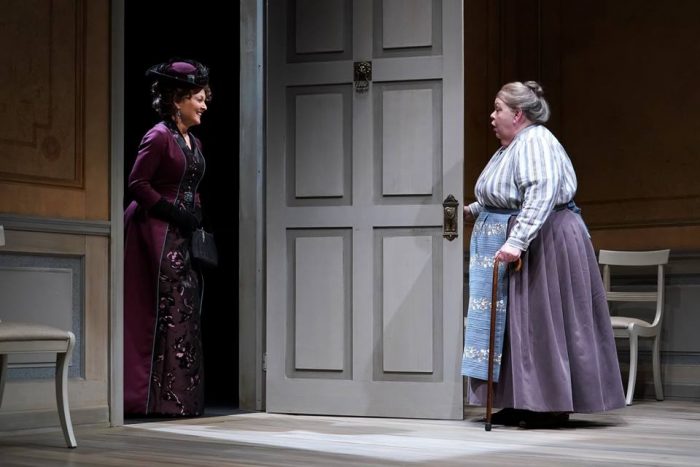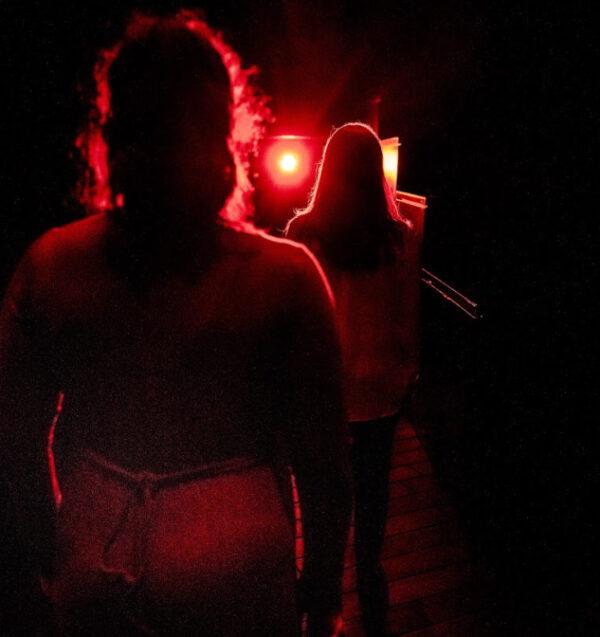Review: A Doll’s Life, Part 2 by Lucas Hnath and based on Henrik Ibsen’s A Doll’s House. Produced by Seattle Repertory Theatre. Directed by Braden Abraham. Scenic Design by Carey Wong. Costume Design by Deborah Trout. Lighting Design by L.B. Morse. Original Music and Sound Design by Obadiah Eaves. With Pamela Reed, Michael Winters, Khanh Doan, Laura Kenny. Now through April 28, 2019 at Seattle Rep.

“Guess Who’s Baaaaaack??!!??” Pamela Reed is Nora and Laura Kenny is Anne Marie in Seattle Rep’s production of Lucas Hnath’s unnecessary sequel A DOLL’S HOUSE, PART 2. Photo: Alan Alabastro
Playwright Lucas Hnath thought so and wrote A DOLL’S HOUSE PART 2 which follows up on the story of Nora Helmer, the 19th century Norwegian housewife who infamously slammed the door to her marriage and propriety and societal (but actually mostly male) expectations of what a woman is supposed to be: a good wife, mother, housekeeper, hostess….a doll in a playhouse.
Ibsen’s play shocked the world because…well, it WAS shocking. A Doll’s House feels a bit dated today, both in reading and performance but in 1879 it was a dangerous piece of literature, getting at truths hidden behind the wall of propriety and traditional values. Despite being written by a man, A Doll’s House is a feminist manifesto declaring marriage is a trap and a prison for women. Nora Helmer leaving her home, her husband, her children and her designated place in society was a dangerous and revolutionary act. That final door slam is powerful and significant. She has left everything behind that a woman could possibly leave behind. And, we ask ourselves: “What is her future?”
That question has bothered and (delightfully) perplexed many readers/audience members for the thousands of productions over the last 140 years. “What happened to Nora Helmer?” “Where did she go?” and “What did she do?” and “What was her ultimate fate?” Those questions have been asked for decades and more than one writer has tried to answer them including the odd musical version A Doll’s Life in 1982 (it’s a notorious flop musical).
Rising young playwright Lucas Hnath was commissioned by South Coast Rep to write a play and his take on Nora’s fate after she slammed that damn door became a hot property and was quickly produced on Broadway (simultaneously with its debut at South Coast Rep) with direction by Sam Gold and starring Laurie Metcalf as Nora with Chris Cooper as husband Torvald, Jayne Houdyshell as faithful serant Anne Marie, and Condola Rashād as the now grown up daughter Emmy. The play received positive reviews and 8 Tony Award nominations (including all four cast members) with Metcalf winning the Best Actress Tony.
Set 15 years later, the play naturally opens with a knock at the door of the Helmer household and the return of Nora herself. She’s back in town because she’s in a pickle…since leaving her family, Nora has become a very successful feminist novelist and, assuming Torvald had divorced her, lived a life as an independent and successful woman…including signing contracts and having many lovers. After she discovers she is not actually “free” from Torvald and thus liable for prosecution for signing contracts illegally and having adulterous affairs, all things she could be imprisoned for, she now must convince Torvald to make their separation legal.
Naturally, this isn’t easy as there are some hard feelings involved, especially from nanny Anne Marie (who had also raised Nora herself) and from Torvald, though not as many from daughter Emmy who really doesn’t remember her, (the two Helmer sons are mentioned but not seen). The ninety minute-ish one act play, all set in one stripped down room in the Helmer household takes place over the course of a day as Nora touches base with all three family members. Distancing itself from the stiff style of Ibsen’s play, Hnath takes a modern approach to the material and the characters and the style of telling the story; the language is very contemporary and frank with a lot of humor derived from hearing the 70 year old nanny proclaim “Well, shit, Nora!” as well as numerous droppings of the “F-Bomb”.
It’s a hip and “woke” kind of play.
A Doll’s House, Part 2 has some clever dialogue. It’s an interesting premise, though if you think very hard about the main plot point, it doesn’t make much sense; Nora is presented as an intelligent person and one determined to obtain her freedom from her marriage. Why would she casually assume she was divorced and not seek out confirmation at some point in the years she has been gone? Especially if she’s doing business as a supposedly single woman and having casual sexual relationships with quite a few men. It’s not only illogical but it’s also unlikely…it’s a bit lazy in fact, storytelling wise, that the entire play depends on Nora being that willfully obtuse.
And, naturally, we’re hearing Torvald’s side of the story as well as the other characters, on how Nora’s original abandonment effected them all which frankly robs the original Ibsen story of its power. A Doll’s House is Nora’s Story…it’s her cry for freedom. Is abandoning your life and family a “nice” thing to do? No, but that’s kinda/sorta/totally the point of Nora’s story and the feminist power of the original play. It is hard. It is messy. It’s not “nice”. It’s very complicated to escape the shackles of a sexist society. Bringing up Torvald’s woes…who cares? The play is not about him. (And, Hnath does have his Nora counter all of Torvald’s denials and accusations; she’s not meekly taking anything in “Part 2”.)
But, that’s a chief problem with this play, for me. I don’t want to hear all the sides in this story. I don’t actually need to know anything about the fate of Torvald or Anne Marie or the kids or even Nora herself. All the power of the story is summed up by her slamming that door at the end of Ibsen’s masterpiece. Whatever colorful tales we concoct afterward are not important and actually detract from that. Nora doesn’t need an afterlife and she certainly doesn’t need to go down memory lane with Torvald. It’s insulting to her and it’s insulting to the original intent and it’s insulting to women.
So. I obviously have issues with the play itself. It feels unnecessary and even exploitative at times…like it’s making excuses for feminism. That said, it does have moments of interest while also having moments where it just feels draggy. The modern language used does amuse, though having 19th century bourgeoisie characters cursing in a very 21st century sort of way is pandering. I think the actors in Seattle Rep’s production do a good job though I don’t think they’re especially well directed by the Rep’s artistic director Braden Abraham. They mostly just roam around the bare room (handsomely designed by Carey Wong and lighted by L.B. Morse with gorgeous costumes by Deborah Trout) and pose a lot; it’s awkwardly staged like junior high kids at their first dance unsure where they’re supposed to go or how they’re supposed to behave.
To be honest, it’s modestly entertaining at times while fundamentally a flawed piece of material. Like many sequels/reboots it’s just not necessary. We don’t really need the return of Geriatric Murphy Brown or Bill & Ted’s Middle Aged Enlarged Prostate Adventures or Whatever Happened to Nora Helmer.
















